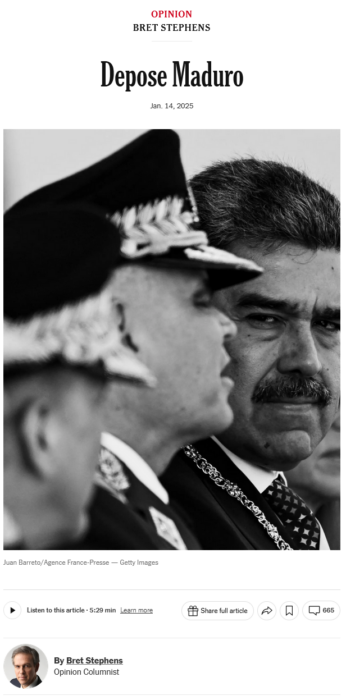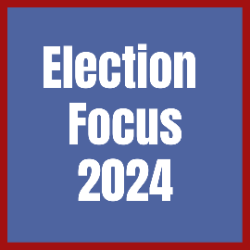 The murder of UnitedHealth Group executive Brian Thompson, and the subsequent arrest of Luigi Mangione, focused media and policymakers’ attention on the savage practices of private US health insurance. In the immediate aftermath, major media outlets scolded social media posters for mocking Thompson with sarcastic posts, such as “I’m sorry, prior authorization is required for thoughts and prayers.”
The murder of UnitedHealth Group executive Brian Thompson, and the subsequent arrest of Luigi Mangione, focused media and policymakers’ attention on the savage practices of private US health insurance. In the immediate aftermath, major media outlets scolded social media posters for mocking Thompson with sarcastic posts, such as “I’m sorry, prior authorization is required for thoughts and prayers.”
As public fury failed to subside, it began to dawn on at least some media organizations that the response to Thompson’s murder might possibly reflect deep, widespread anger at a healthcare system that collects twice as much money as those in other wealthy countries, makes it difficult for half the adult population to afford healthcare even when they’re supposedly “insured,” and maims, murders and bankrupts millions of people by denying payment when they actually try to use their alleged benefits. As Rep. Ro Khanna (D.–Calif.) said to ABC News (12/8/24), “There is no justification for violence, but the outpouring afterwards has not surprised me.”
Any reporter, editor or pundit who writes regularly about healthcare and professes to be mystified or outraged by the public reaction to Thompson’s murder should take a deep look at their own assumptions, sources and professional behavior.
FAIR reviewed coverage of healthcare in the presidential election by the New York Times, Wall Street Journal and Washington Post, as well as KFF Health News (KHN), the leading outlet specializing in the healthcare issue, whose reporting is often picked up by corporate media. The coverage by these outlets amounts to little more than sophisticated public relations for this corporate healthcare killing machine and, especially, the Republican and Democratic politicians who created and nurture it.
The coverage was marred by many of the media failings FAIR has exposed since its inception. These outlets:
- took false major-party “facts” at face value and published candidates’ platitudes without challenging their substance;
- anointed former President Donald Trump and Vice President Kamala Harris as the only legitimate horses in the race, blacking out the content of third-party candidate proposals like “Medicare for All”; and
- added insult to injury by legitimizing their own failed coverage with analysis asking why there were no major healthcare reform proposals to cover.
Tsunami of fake good news
In March 2024, I reported (Healing and Stealing, 3/23/24) that Democrats were preparing to unleash a “tsunami of fake good news” about healthcare and the Affordable Care Act to try to influence media coverage of the campaign.
Major media fell for it hook, line and sinker. No campaign tactic and media failure did more to lengthen the distance between a public brutalized by a failing healthcare system and an out-of-touch corporate media.
President Joe Biden (until he dropped out) and Harris spun a narrative of “progress” under the Affordable Care Act to attract voters. The progress narrative relied on two new healthcare policy “records”: a record-low uninsurance rate and record-high Obamacare enrollment.
In a story on why “big, prominent plans for health reform are nowhere to be seen,” the New York Times’ Margot Sanger-Katz (9/13/24) explained that the “overall state of the health system” is different than in 2019 for several reasons, including that the “uninsured rate is near a record low.”
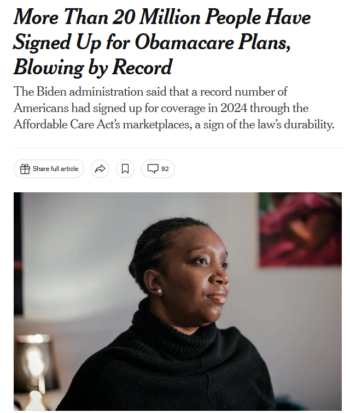
The New York Times (1/10/24) reported that signups for the ACA set a “record”—but not that this was less than the number of people who had been kicked off Medicaid.
KHN’s Phil Galewitz (9/10/24) similarly reported:
Before Congress passed the ACA in 2010, the uninsured rate had been in double digits for decades. The rate fell steadily under Barack Obama but reversed under President Donald Trump, only to come down again under President Joe Biden.
Meanwhile, insurance plans sold on the Affordable Care Act exchanges reached a record enrollment of 21 million in early 2024, or, as the Times’ Noah Weiland (1/10/24) put it, “blowing by the previous record and elevating the health and political costs of a repeal.”
The two “facts” are both distorted and largely irrelevant to people’s actual experience of the healthcare system. As Galewitz acknowledged, because of survey lags, the uninsurance data don’t reflect the 2023–24 disenrollment of some 25 million from Medicaid, the joint federal/state insurance program for low-income Americans, which had been temporarily expanded under Covid.
But the Medicaid disenrollment is reflected in the record signups to Obamacare, where some of those who lost Medicaid coverage fled in 2024. Yet according to KHN, 6 million of the 25 million people who lost Medicaid coverage became uninsured. Most of them haven’t yet been captured in uninsured data, allowing the Democrats to have their cake and eat it too.
The fact that the uninsured data likely understate uninsurance by as much as 6 million people escaped most political coverage—the Washington Post’s Dan Diamond (9/11/24), for example, added no caveats when reporting that the Biden administration
had released data showing that nearly 50 million Americans have obtained health coverage through the Affordable Care Act’s health insurance exchanges since they were established more than a decade ago, helping lower the national uninsured rate to record lows in recent years.
The Times‘ Sanger-Katz (9/13/24) likewise failed to mention it.
Private insurance ≠ healthcare
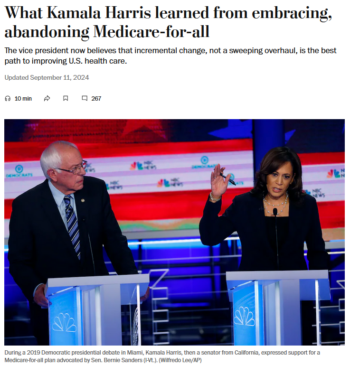
The lesson Kamala Harris learned, according to the Washington Post (9/11/24), is that “incremental change, not a sweeping overhaul, is the best path to improving US healthcare.”
Far more importantly, the rate of uninsurance no longer measures whether or not people have adequate healthcare, or are protected from financial ruin if they get sick or injured. Data show that people who supposedly have insurance can’t get healthcare, rendering the raw uninsurance rate a relatively meaningless measure of the burden of the crisis-stricken US healthcare system.
National surveys by the Commonwealth Fund every two years include one of the few comprehensive attempts to measure underinsurance, and the impact of medical costs on people nominally “covered.” In 2022, Commonwealth found that 46% of adults aged 19–64 skipped needed medical treatment due to out-of-pocket costs. That number included 44% of adults buying insurance through ACA exchanges or the individual insurance market—even with the much-hyped expanded premium subsidies in place.
Commonwealth didn’t release its 2024 surveys until November 21, well after Election Day. During the last two years of the Biden/Harris administration, the percentage of working age adults skipping medical care due to costs increased from 46% to 48%, no matter the source of coverage (Healing and Stealing, 11/21/24).
When people with private insurance do attempt to get healthcare, their insurers often refuse to pay for care. The slain Brian Thompson was CEO of UnitedHealth Group’s insurance subsidiary. According to an analysis of federal data by ValuePenguin (5/15/24), a consumer website run by online lender LendingTree, UnitedHealthcare denied 32% of claims submitted to its ACA and individual market plans in 2022, the highest rate in the industry.
Corporate media political reporters usually delivered the misleading progress narrative “facts” without reference to this critical context. The Washington Post’s Dan Diamond (9/11/24), explaining that Harris learned “the importance of incremental progress” as vice president after retreating from support for Medicare for All, noted the administration’s achievement of “record levels of health coverage through the Affordable Care Act,” with no reference to the Medicaid purge or underinsurance.
Substance-free coverage of a substance-free campaign
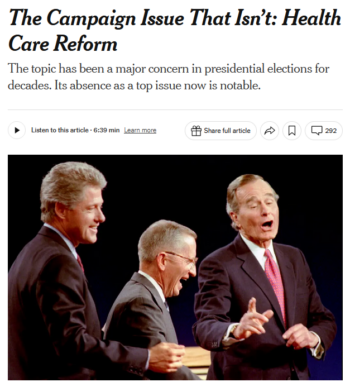
New York Times (9/13/24): “After years of crises and emergencies, no part of the system is currently ablaze.”
The New York Times’ Margot Sanger-Katz wrote in “The Campaign Issue That Isn’t: Healthcare Reform” (9/13/24):
As you may have noticed, with less than two months until Election Day, big, prominent plans for health reform are nowhere to be seen. Even in an election that has been fairly light on policy proposals, healthcare’s absence is notable.
It’s true that neither Harris nor Trump offered any concrete proposals for improving US healthcare. Harris campaigned on “strengthening” the ACA, but her only specific “improvement” was a promise to support keeping the expanded subsidies that help people pay their ACA health insurance premiums—passed in the first year of Biden’s term—from expiring as scheduled next year. In other words, “strengthen” the ACA by maintaining its dismal status quo.
As for Trump, the Times’ Weiland (8/12/24) reported that the authors of Project 2025, the consensus right-wing NGO blueprint published by the Heritage Foundation, “were not calling for a repeal of the Affordable Care Act.” At the debate, Trump said he wouldn’t repeal unless he had a better plan, and drew mockery for saying he had “concepts of a plan.”
Ultimately, mass deportation was his primary healthcare policy (Healing and Stealing, 10/16/24, 9/10/24); the RNC Platform maintained that undocumented immigrants were the cause of high healthcare costs. (It’s nonsense. Undocumented taxpayers actually paid more in taxes that were earmarked specifically for healthcare in 2022 than the estimated total cost of healthcare for all undocumented immigrants in the US.)
What you see depends on where you look
One reason Sanger-Katz and colleagues had a hard time finding “big” plans for healthcare is that she and her colleagues chose to look for them only in the two major parties’ platforms.
Whether Eugene Debs campaigning for Social Security from prison in 1920, Henry Wallace fighting for desegregation after walking out of the 1948 Democratic convention, or Cynthia McKinney proposing an end to the Afghan War in 2008, third-party candidates have a long track record of promoting policies dismissed as unrealistic ideological fantasies that later become consensus policy. Yet corporate media outlets repeat the same failure to pay attention every four years (FAIR.org, 10/23/08).
Green Party candidate Jill Stein, the only medical doctor in the race, supported Medicare for All as a
precursor to establishing a British-style National Healthcare Service which will replace private hospitals, private medical practice and private medical insurance with a publicly owned, democratically controlled healthcare service that will guarantee healthcare as a human right to everyone in the United States.
Stein placed special emphasis on taking “the pharmaceutical industry into public ownership and democratic control.”
Justice for All Party candidate Cornel West’s Health Justice agenda also envisioned a system “Beyond Medicare for All,” including “nationalization of healthcare industries.”
Prior to suspending his campaign and endorsing Trump, Robert F. Kennedy Jr. told Jacobin (6/9/23) he would keep private insurance for those who want it, but also have a public program “available to everybody.” Although he used the phrase “single-payer,” Kennedy described a program most similar to a voluntary “public option,” an untested idea whose ultimate impact on the breadth, depth and cost of coverage remains speculative.
Outside the world inhabited by elite media, Medicare for All is a fiscally modest proposal that receives consistent support among large segments of the US population, reaching majorities depending on the wording of poll questions (KFF, 10/26/20). In 2022, the Congressional Budget Office (2/22) estimated that a single-payer system with no out-of-pocket costs for doctor visits or hospital care, minimal copays for prescription drugs, and doctor and hospital prices at the current average would cover everyone for all medical conditions—including services that are almost never fully covered, like vision, dental and hearing—and still lower expected total national health expenditures by about a half a percent.
Even with candidates in the race proposing even broader expansion of the public role in healthcare, through nationalizing hospitals and drug manufacturing, Medicare for All remains beyond the boundary of acceptable corporate media debate. This has been true for 30 years, when FAIR (Extra!, 1–2/94) reported on media coverage of the failed Clinton administration healthcare reform effort.
Just one election cycle back, during the Democratic primaries, multiple candidates—led by Vermont Sen. Bernie Sanders, but also including Kamala Harris—supported Medicare for All, and media were forced to cover it, generally with considerable hostility (FAIR.org, 3/20/19, 4/29/19, 10/2/19). But with Harris backing away from it entirely, media found themselves returning to a place of comfortably ignoring the popular proposal.
Missing Medicare for All
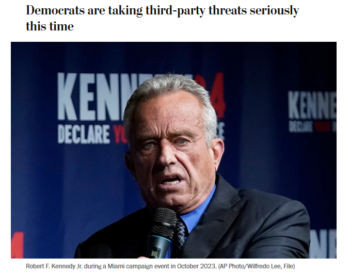
Leading papers covered third parties as potential spoilers, but not as potential sources of new ideas (Washington Post, 3/14/24).
FAIR searched the Nexis, ProQuest and Dow Jones databases, and the websites of the New York Times, Washington Post, Wall Street Journal and KFF Health News, for election or healthcare policy stories and podcasts mentioning different iterations of “Medicare for All,” “single-payer” and “universal healthcare,” between January 1 and Election Day 2024. We found 89 news and 107 opinion pieces.
Ninety percent of the news articles came after Biden dropped out of the race. The coverage overwhelmingly focused on Harris’s reversal of her brief support for Medicare for All in 2019, with 96% of these stories mentioning her shift.
The ubiquitous Republican claim that Harris sought to give undocumented people free Medicare was based on the obviously false premise that Harris had not abandoned support for Medicare for All. Asked in 2019 whether her support for universal health insurance would include eligibility for undocumented immigrants, she said yes (New York Times, 10/30/24). Since that time, Harris has repudiated Medicare for All, and no Democrat has advocated enrolling the 11 million undocumented immigrants in Medicare, let alone for “free.”
KHN (8/1/24) and the New York Times (10/30/24) corrected this GOP distortion, but all four outlets left readers hard-pressed to learn any other details of Medicare for All, or other meaningful alternatives to the status quo, especially not any proposed by other candidates.
All four outlets wrote frequently about whether third-party candidates might siphon votes from Trump or Harris (e.g., Wall Street Journal, 11/10/23; Washington Post, 3/14/24; New York Times, 10/14/24). However, they blacked out the content of those parties’ healthcare policy positions, leaving readers with no information to help them decide if voting for a candidate other than Trump or Harris might benefit them.
Voters in the dark
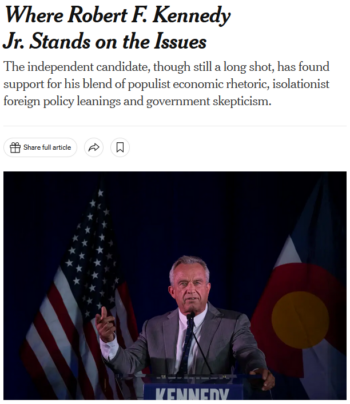
In 2,000 words on “Where Robert F. Kennedy Jr. Stands on the Issues,” the New York Times (6/14/24) avoided any discussion of where he stands on major healthcare reform issues.
The New York Times, Washington Post, Wall Street Journal and KHN frequently mentioned one or more of the third-party candidates in other political coverage as a threat to the major-party candidates. But out of the 89 news articles bringing up Medicare for All, single-payer or universal healthcare, only three included third-party candidates at all, each one in passing as possible spoilers. Exactly zero offered any information at all about the candidates’ healthcare proposals.
For example, the New York Times published 34 news articles and podcasts mentioning a version of Medicare for All or single-payer, without a single word on the healthcare proposals of the third-party candidates who remained after Kennedy’s endorsement of Trump. One article (10/24/24) included a passing Stein spoiler reference. Another (8/22/24), on Harris’s commitment to “the art of the possible,” quoted West’s vice presidential running mate, Melina Abdullah, criticizing Harris for shifting many of her policy positions, but again without reference to West and Abdullah’s proposals for healthcare.
Times readers were more likely to get news about the healthcare reform positions of foreign political leaders than non–major-party candidates running for president of the United States. The paper ran six stories about Indonesia (2/12/24, 2/15/24, 10/19/24), Thailand (2/18/24) and South Africa (6/3/24, 6/7/24) that mentioned a politician’s position on “universal healthcare,” while blacking out discussion of third-party candidates’ healthcare proposals, except to some degree for Robert F. Kennedy Jr.
Before leaving the race, Kennedy’s half-baked notions about vaccines, activism on environmental health and food safety, and criticism of Covid lockdowns received frequent mention, but as with the other third-party candidates, his views on major healthcare reform issues went missing, including from a 2,000-word Times analysis of “Where Robert F. Kennedy Jr. Stands on the Issues” (6/14/24).
The third-party healthcare blackout was even tighter in the Washington Post. The 38 Post news articles mentioning Medicare for All or single-payer had only one reference to Stein or West—a quote from West unrelated to healthcare (8/21/24). The Post never reported either candidate’s healthcare proposals. A webpage on which reporters tracked third-party ballot access offered a short “Pitch to Voters” for each party that included no healthcare policy.
Medicare for All spin and bad facts
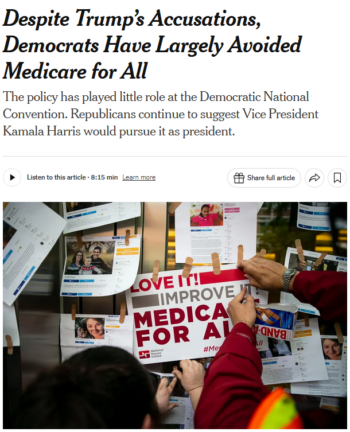
Like Democrats, the New York Times‘ Noah Weiland (8/22/24) largely avoided talking about what Medicare for All would do.
The four outlets’ descriptions of Medicare for All, single payer and universal healthcare were nearly as sparse as coverage of third-party candidates’ healthcare positions, and as distorted as reporting on the ACA. Only 23 of the 89 news stories included any description at all of these policies, the overwhelming majority of them a brief phrase in the reporter’s own words.
Only three New York Times stories included any Medicare for All substance, and these were barely intelligible. The most extensive was an article debunking Trump’s claims that Harris continued to support the policy, in which Noah Weiland (8/22/24) wrote nearly 1,300 words without explaining what the Medicare for All is or would do. Readers wouldn’t know that the current Medicare for All bills before Congress would cover everyone in the country with no out-of-pocket costs, and free choice of doctors and hospitals. They would, however, have learned that Harris “proposed a less sweeping plan” in 2019, which would include “a role for private plans.”
Weiland treated readers to what may be the most emphatic recitation of the ACA progress narrative. Biden’s pursuit of a “more traditional set of healthcare priorities” has yielded “explosive growth” in the ACA exchanges, he wrote. According to unnamed experts, that growth, and changes to Medicare and Medicaid, have “complicated” pursuit of Medicare for All.
Times readers would also have learned that expanding Medicaid is an incremental step toward Medicare for All, what bill supporter Rep. Ed Markey says is part of the policy’s “DNA.” In reality, Medicaid’s eligibility standards are literally the opposite of Medicare for All—means-tested coverage that requires you to prove you’re appropriately impoverished every year, and which disappears if you get a big enough raise at your job.
The vast majority of Times coverage of Medicare for All included no content whatsoever, simply mentioning it as a policy that Harris once supported, with the occasional political characterization (7/24/24) that it was one of her since-abandoned “left-leaning positions that can now leave her vulnerable to attack from Republicans.”
‘A proposal that worried many Americans’
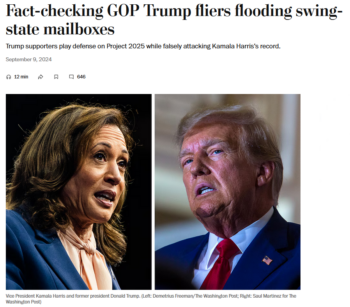
Washington Post factchecker Glenn Kessler (9/9/24) said it was mostly true that Medicare for All would “raise taxes [and] increase national debt,” citing studies of Bernie Sanders’ plan that “estimated that national health expenditures would rise over 10 years.” He didn’t note that CBO found that under most single-payer plans, national health expenditures would rise—but much less than they would under the status quo.
Eleven of the 36
Washington Post stories in our sample published after Biden’s withdrawal made some substantive policy comment about Medicare for All, all but three in a single passing phrase. Every article except one said that Medicare for All would “abolish” or replace private insurance, sometimes noting private insurance would be replaced by a “government” plan—using the
industry-preferred framing instead of the more neutral descriptor “public.” In the majority of stories, this was the only substantive point made about Medicare for All.
The Post‘s Glenn Kessler (9/9/24) “factchecked” Republican claims that Medicare for All would “raise taxes, increase national debt and functionally eliminate private health insurance.” Calling it “mostly true,” Kessler cited the figure of $32.6 trillion over 10 years, and claimed that “four of the five key studies on the effect of the Sanders plan estimated that national health expenditures would rise over 10 years.”
Kessler skipped a big fact. When the CBO insisted that raising the minimum wage would cause 1.4 million lost jobs, his editors (4/18/21) indignantly defended the agency as “admirably apolitical.” But Kessler neglected to mention that the “nonpartisan scorekeepers” at the CBO (12/10/20) found that four of the five versions of single-payer healthcare that they analyzed would raise national health expenditures, but by significantly less than preserving the status quo.
Healthcare reporter Dan Diamond (9/11/24) wrote the Post’s most detailed take on Harris’s about-face on a plan “to eliminate private insurance, a proposal that worried many Americans who feared losing access to their doctors.” Diamond managed not to let readers know that, in contrast to private insurance plans that penalize patients for seeing “out-of-network” doctors, Medicare for All would free patients to see any doctor they want without financial penalty.
Diamond added that Harris pulled back from Medicare for All because “polls across 2019 found that many Americans were worried that shifting to a national government-run health system could delay access to care,” without mentioning that half of all American working adults already skip treatments altogether every year (Commonwealth, 11/24).
Voters’ 2019 “worries” were likely stimulated in part by a multi-million-dollar lobbying and advertising blitz by the hospital, insurance and pharmaceutical industries, reported on by the Post‘s Jeff Stein (4/12/19), and based on the same distortions and inaccuracies Diamond and Kessler repeated five years later (Public Citizen, 6/28/19).
In a story (Washington Post, 4/3/20) on Sen. Bernie Sanders supporting the Biden/Harris administration’s drug cost control policies, Diamond reported that during the 2020 primaries, Sanders “argued that Medicare for All would help rein in high drug costs by forcing pharmaceutical companies to negotiate with the government.” It was the only positive framing of Medicare for All we could find in the Post’s coverage. Biden and Harris have done exactly what Sanders proposed, although to date they’ve only negotiated lower prices for 10 drugs, the prices won’t take effect for another year, and they only apply to our current “Medicare for Some.”
Expert content suppression

KFF’s website limited its discussion of candidates’ healthcare proposals to the “viable contenders”—a choice that excluded virtually all ideas for improving the US healthcare system.
No outlet ignored the third-party candidates’ healthcare proposals more firmly, or took the tiny increments proposed by the major parties more seriously, than the one best equipped to inform the public about the state of US healthcare: KFF Health News.
KHN is a subsidiary of what used to be known as the Kaiser Family Foundations, but now goes by the acronym KFF. Founded with money from the family of steel magnate Henry Kaiser, tax-exempt KFF occupies a unique role as both news outlet and major source for healthcare information, calling itself “a one-of-a-kind information organization.”
KFF’s research and polling arms publish a large volume of detailed data and analysis of healthcare policy, covered widely in the media. This work lends additional credibility to KHN’s respected and widely republished news reporting.
With a staff of 71 reporters, editors, producers and administrators, as of November 1, KHN is devoted entirely to healthcare. Unlike taxpaying competitors like Modern Healthcare and Healthcare Dive—which regularly cover KFF’s research output—KHN publishes without a paywall, and permits reprints without charge. KHN forms partnerships with outlets of all sizes and focus, from an in-depth investigative series on medical debt with NPR and CBS News, to providing regular policy and political reporting to the physician-targeted website Medscape.
Excluding opinion articles, letters to the editor and brief daily newsletter blurbs linking to other outlets’ content, FAIR’s searches yielded just five KHN news stories from January 1 to Election Day that referred to Medicare for All, single-payer or universal healthcare. Two were state-focused—a one-paragraph mention of a proposed California single-payer bill in a broader legislative round-up (4/24/24), and a profile (7/15/24) of Anthony Wright, newly appointed executive director of the DC nonprofit Families USA.
The remaining three (7/21/24, 8/1/24, 9/11/24) were passing mentions without substance. KHN went the entire year without once mentioning Jill Stein or Cornel West.
KHN’s news coverage appeared to follow the lead of its affiliated research entity. KFF published a web page to “Compare the Candidates on Healthcare Policy,” last updated October 8, that declared
the general election campaign is underway, spotlighting former President Trump, the Republican nominee, and Vice President Harris, the Democratic nominee, as the viable contenders for the presidency.
The comparisons highlighted the differences rather than the similarities, and included without context the standard claim that the Biden/Harris “administration achieved record-high enrollment in ACA Marketplace plans.”
KFF had long since decided that discussion of Medicare for All is over. President Drew Altman told the New York Times (8/22/24) that KFF stopped polling on Medicare for All after the 2020 primaries because “there hasn’t been debate about it.” Yet pollsters regularly ask voters about healthcare issues that have no immediate chance of passage. The AP has asked people for a quarter century if they think it’s the federal government’s responsibility to “make sure all Americans have healthcare coverage,” and the Pew Research Center and other organizations have polled on abortion for decades, even when federal legislation was extremely unlikely.
The lack of “debate” about Medicare for All or single-payer is a flimsy excuse for blinkered coverage. In fact, KHN and the other outlets all ignored major healthcare reform stories with looming deadlines for action by the incoming president—federal approval for state-level reform (Healthcare Dive, 4/24/24). California and Oregon passed laws in 2023 instructing their governors to seek federal permission to dramatically restructure their state healthcare systems, including formation of a single-payer system in Oregon. Negotiations were supposed to begin in the first half of this year. None of these four agenda-setting outlets asked 2024 presidential candidates whether they planned to flex White House power to help major state-level reforms.
Complicit in mass death
All four of these outlets have done detailed reporting on some aspects of the extraordinarily expensive mass-killing machine that passes for the US “healthcare system.” Claims denials, aggressive collections, medical debt and massively inflated prices have all graced their pages.
But when it comes to political coverage, reporters and editors refuse to use their knowledge to challenge candidates effectively. The public’s experiences disappear, as journalists regurgitate bad facts and focus on self-evidently meaningless “proposals” framed by corporate power within their insular Beltway cultural bubble.
UnitedHealth Group executive Brian Thompson’s murder exposed the degree to which that behavior makes them complicit in mass death.
This post was originally published on FAIR.



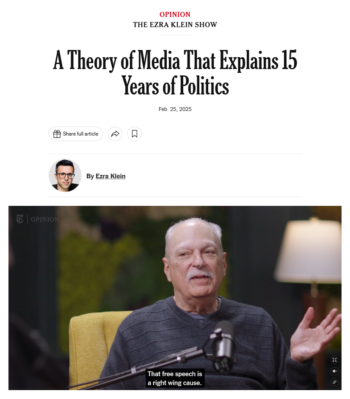

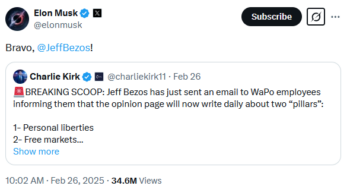


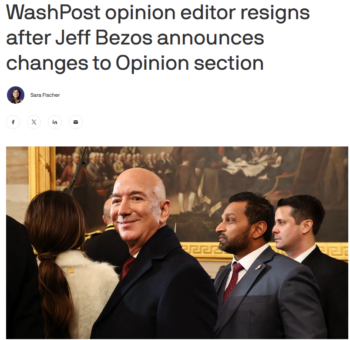
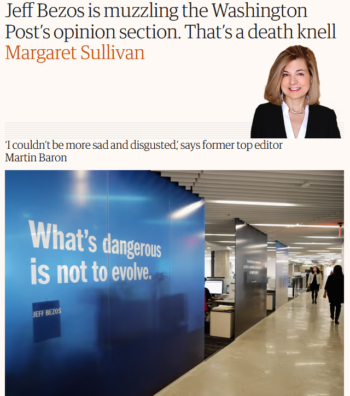
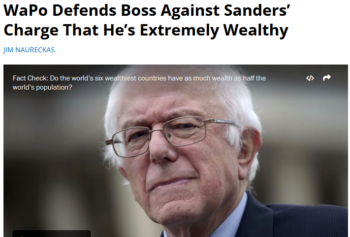
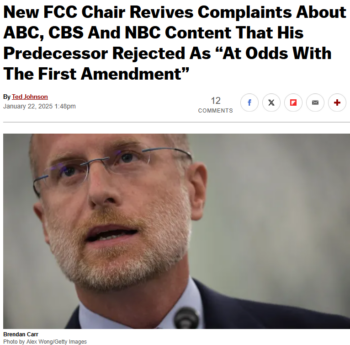
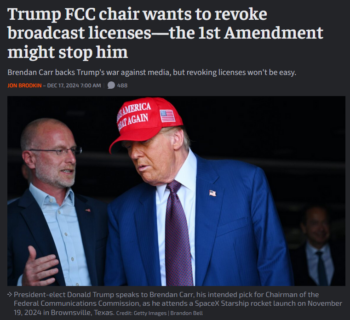




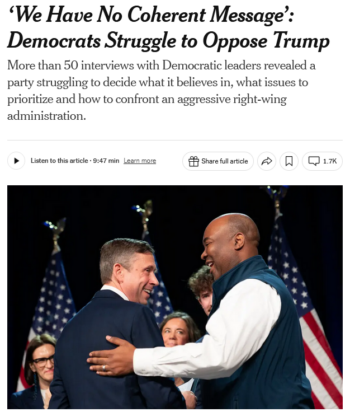
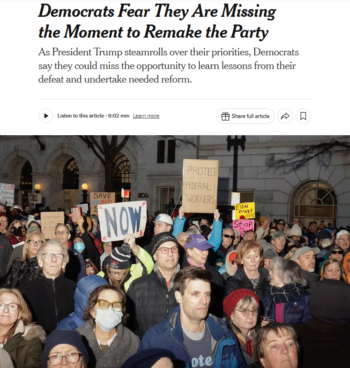

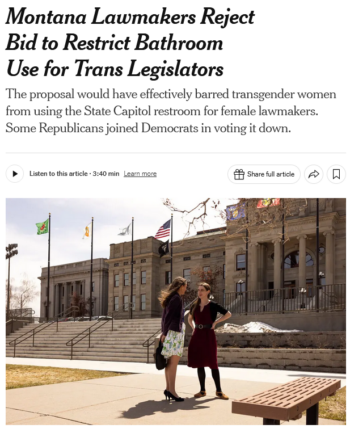





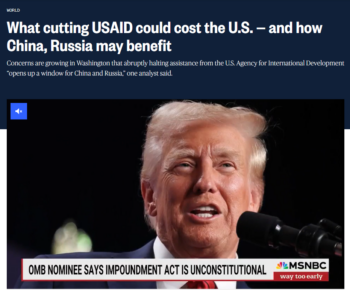
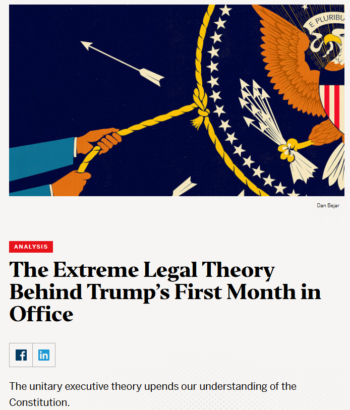
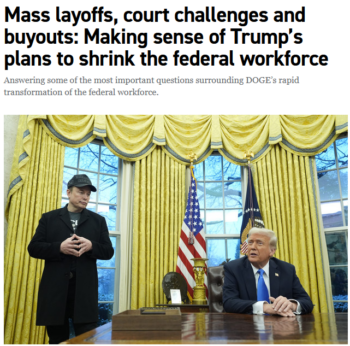
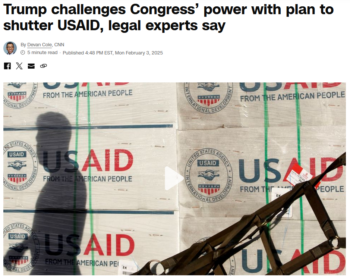












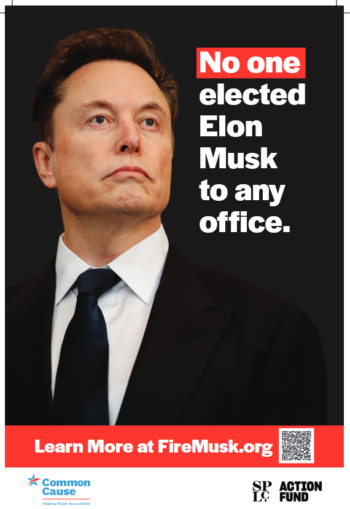







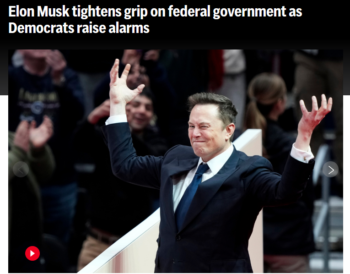

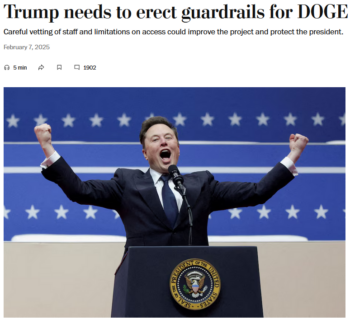
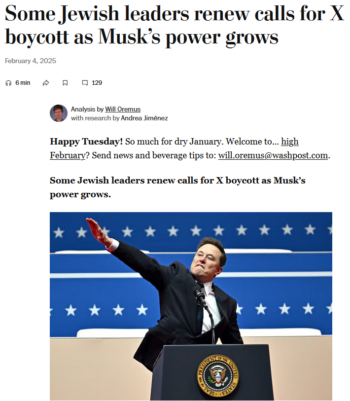
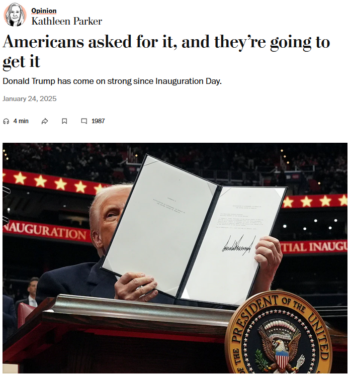




 The murder of UnitedHealth Group executive Brian Thompson, and the subsequent arrest of Luigi Mangione, focused media and policymakers’ attention on the savage practices of private US health insurance. In the immediate
The murder of UnitedHealth Group executive Brian Thompson, and the subsequent arrest of Luigi Mangione, focused media and policymakers’ attention on the savage practices of private US health insurance. In the immediate 









